SNMP (
Simple Network Management Protocol
) — это классический протокол для мониторинга и сбора информации о сетевых устройствах (сервера, сетевое оборудование, рабочие станции, принтеры и т.д.). Протокол SNMP довольно легкий, быстрый, для передачи данных использует UDP порты 161 и 162. В этой статье мы рассмотрим, как установить и настроить службу SNMP в Windows Server 2022/2019 и Windows 10/11.
Содержание:
- Установка службы SNMP в Windows Server 2022/2019
- Установка SNMP агента в Windows Server Core
- Установка службы SNMP в Windows 10/11
- Настройка службы SNMP в Windows Server и Windows 10/11
Установка службы SNMP в Windows Server 2022/2019
В Windows Server службу SNMP можно установить с помощью Server Manager.
Выберите Add roles and features -> Features. Выберите SNMP Service (если нужно отметьте также SNMP WMI Providers).
Служба SNMP WMI Provider позволяет опрашивать SNMP устройство через WMI.
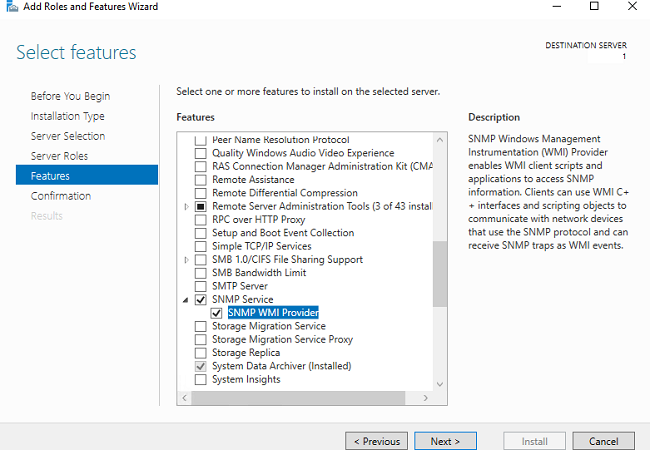
Нажмите Next -> Install и дождитесь окончания установки.
Установка SNMP агента в Windows Server Core
В Windows Server Core можно установить SNMP с помощью веб-интерфеса Windows Admin Center и PowerShell.
Если вы используете Windows Admin Center, подключитесь к хосту Windows Server, выберите Roles and Features -> SNMP Service.

Т.к. в Windows Server Core отсутствует графический интерфейс, а для его управления используется командная строка, вы можете установить службу SNMP из командной строки PowerShell.
Для установки ролей в Windows Server из PowerShell используется командлет Install-WindowsFeature.
Проверьте, что служба SNMP не установлена:
Get-WindowsFeature SNMP*

Установите роль SNMP и WMI провайдер:
Install-WindowsFeature SNMP-Service,SNMP-WMI-Provider -IncludeManagementTools
Проверьте, что службы SNMP запущены:
Get-Service SNMP*
В нашем примере SNMP служба запущена, а SNMPTRAP остановлена.
Установка службы SNMP в Windows 10/11
Вы можете использовать службу SNMP не только в Windows Server, но и в десктопных редакциях Windows 10 и 11.
В Windows 10/11 служба SNMP, вынесена в отдельный компонент Feature On Demand (как RSAT и OpenSSH).
Вы можете установить SNMP через панель Settings. Перейдите в Apps -> Optional features -> Add an optional feature -> View features.
В списке доступных компонентов выберите Simple Network Management Protocol (SNMP) и WMI SNMP Provider. Для начала установки нажмите Next (понадобится интернет подключение к серверам Microsoft).
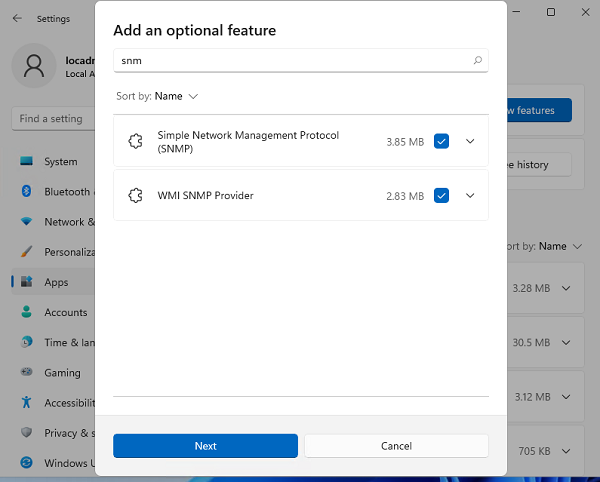
Для установки службы SNMP через PowerShell, используйте команду:
Add-WindowsCapability -Online -Name SNMP.Client~~~~0.0.1.0
Для установки службы SNMP без подключения к интернету, вам понадобится скачать ISO образ Windows 10/11 Features on Demand из личного кабинета на сайте лицензирования Volume Licensing Service Center (VLSC).
Для офлайн установки службы SNMP с такого ISO образа используется команда:
Add-WindowsCapability -Online -Name SNMP.Client~~~~0.0.1.0 -LimitAccess -Source \\msk-fs01\Distr\Windows-FOD\Win11\
Настройка службы SNMP в Windows Server и Windows 10/11
Вы можете настроить параметры службы SNMP в консоли services.msc. Найдите службу SNMP Services в списке и откройте ее свойства.
Обратите внимание, что у службы SNMP есть несколько дополнительных вкладок:
- Agent
- Traps
- Security
На вкладке Agent указывается базовая информация об устройстве (контакты администратора, местоположение). Здесь же можно указать тип информации, который может отправлять данное устройство при SNMP опросе.

В старых версиях протокола SNMP (SNMP v.1 и SNMP v.2) для авторизации пользователя используется строка сообщества (community string). На вкладке Security можно создать несколько строк подключения.
Можно выбрать один из пяти уровней доступа для сообщества:
- READ ONLY — позволяет получать данные с устройства;
- READ WRITE — позволяет получать данные и изменять конфигурацию устройства;
- NOTIFY — позволяет получать SNMP ловушки;
- READ CREATE – позволяет читать данные, изменять и создавать объекты;
- NONE
Вы можете создать несколько community string. Для этого нужно задать имя и выбрать права/ Для мониторинга состояние сервера достаточно выбрать READ ONLY.
В списке Accept SNMP packets from these hosts можно указать имена/IP адреса серверов, которым разрешено опрашивать данное устройство. Если вы не хотите ограничивать список разрешенных устройств, оставьте здесь Accept SNMP packets from any hosts.
На вкладке Traps указываются адрес серверов, на который SNMP агент должен отправлять SNMP-ловушка (SNMP trap). SNMP Trap это широковещательный USP пакет, используемый для асинхронного уведомления менеджера (например, сообщение о критическом событии).
Не забудьте открыть в Windows Defender Firewall правила, разрешающие входящий и исходящий трафик для SNMP запросов и ловушек (TRAP). Нужные правила фаейрвола можно включить с помощью PowerShell.
В Windows Firewall есть несколько готовых правил для SNMP трафика:
Get-NetFirewallrule -DisplayName *snmp* |ft
- SNMPTRAP-In-UDP
- SNMPTRAP-In-UDP-NoScope
- SNMP-Out-UDP
- SNMP-In-UDP-NoScope
- SNMP-Out-UDP-NoScope
- SNMP-In-UDP
Можно включить все правила, или только определенное:
Get-NetFirewallrule -DisplayName *snmp* | Enable-NetFirewallRule
Get-NetFirewallrule SNMP-Out-UDP | Disable-NetFirewallRule

В списке служб Windows есть еще одна служба SNMP Trap. Она используется для получения сообщений от других SNMP агентов и пересылки на SNMP сервера (обычно это система мониторинга, опрашивающая устройства по SNMP, например PRTG или Zabbix).
Если вы настраиваете SNMP на Windows Server Core, вы не сможете использовать графический интерфейс службы SNMP для настройки ее параметров. Вместо этого придется вносить изменения в реестр с помощью PowerShell. Настройки службы SNMP хранятся в ветке реестра HKEY_LOCAL_MACHINE\SYSTEM\CurrentControlSet\Services\SNMP\Parameters.
Следующие команды зададут описание агента:
New-ItemProperty -Path "HKLM:\SYSTEM\CurrentControlSet\services\SNMP\Parameters\RFC1156Agent" -Name "sysContact" -Value "[email protected]" -PropertyType REG_SZ
New-ItemProperty -Path "HKLM:\SYSTEM\CurrentControlSet\services\SNMP\Parameters\RFC1156Agent" -Name "sysLocation" -Value "MSK_Datacenter1" -PropertyType REG_SZ
Для каждой ловушки SNMP придется создать отдельный ключ в HKLM\SYSTEM\CurrentControlSet\services\SNMP\Parameters\TrapConfiguration с именем community.
New-Item -Path "HKLM:\SYSTEM\CurrentControlSet\services\SNMP\Parameters\TrapConfiguration\public1"
Укажите разрешения для community:
New-ItemProperty -Path "HKLM:\SYSTEM\CurrentControlSet\Services\SNMP\Parameters\ValidCommunities" -Name "public1" -Value 4 -PropertyType DWord
Возможные значения:
- 1 — NONE
- 2 — NOTIFY
- 4 — READ ONLY
- 8 — READ WRITE
- 16 — READ CREATE
Для каждого community можно указать список серверов, с которых разрешено принимать запросы:
New-ItemProperty -Path "HKLM:\SYSTEM\CurrentControlSet\Services\SNMP\Parameters\PermittedManagers" -Name "1" -Value "server1.winitpro.ru" -PropertyType REG_SZ
Перезапустите службу SNMP для применения новых настроек из реестра:
Get-Service SNMP|Restart Service
Если нужно распространить эти SNMP настройки на множество компьютеров/серверов Windows в домене, используйте возможности внесения изменений в реестр через GPO.
Проверить работу службы SNMP можно с помощью утилиты snmpwalk (доступна в любом Linux дистрибутиве):
# snmpwalk -v 2c -c public1 -O e 192.168.13.122
В этом примере мы опросили наш Windows хост через версию протокола SNMPv2.

Утилита вернула базовыую информацию о хосте (syscontact, sysname, syslocation) и довольно большое количество информации о состоянии сервера Windows.
Протокол Simple Network Management Protocol (SNMP) используется для мониторинга, оповещения о событиях и управления устройствами в сети. Протокол состоит из набора стандартов по управления сетью, в том числе протокол прикладного уровня (Application Layer protocol), схемы базы данных и набор объектов данных. SNMP может получать различную информацию (время аптайма, счетчики производительности, параметры устройств и т.д.) от любых сетевых устройств: коммутаторов, серверов, маршрутизаторов или простых компьютеров, на которых установлен агент SNMP.
В Windows 10 служба SNMP доступна в виде отдельного компонента Windows и по умолчанию не устанавливается. Рассмотрим, как установить и настроить SNMP в Windows 10.
- Установка службы SNMP в WIndows 10
- Настройка службы SNMP в Windows 10
Содержание:
Установка службы SNMP в WIndows 10
Вы можете проверить, установлена ли в вашей системе служба SNMP с помощью PowerShell командлета Get-Service:
Get-Service -Name snmp*
Вы можете установить службу SNMP через панель управления. Перейдите в Панель управления\Все элементы панели управления\Программы и компоненты\ Включение или отключение компонентов Windows).
В списке компонентов выберите Simple Network Management Protocol (SNMP)/протокол, и WMI SNMP Provider / Поставщик WMI для SNMP (обеспечивает доступ к информации SNMP через интерфейсы Windows Management Instrumentation) и нажмите Ок.
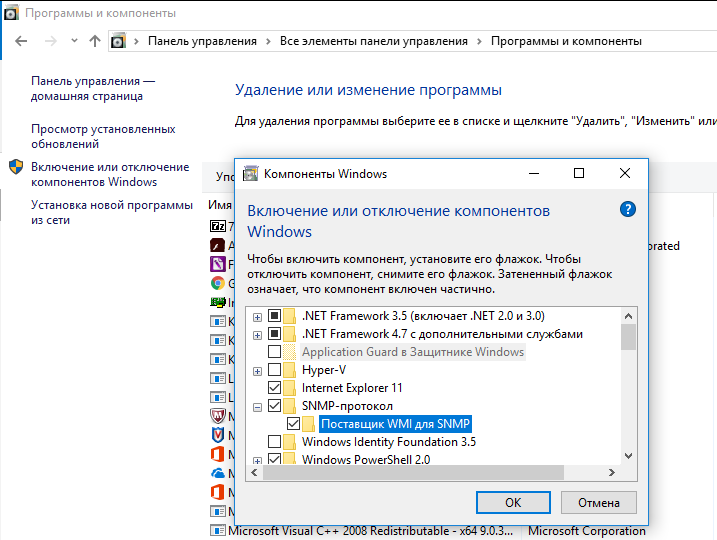
Также вы можете установить службы SNMP из командной строки PowerShell:
Enable-WindowsOptionalFeature -online -FeatureName SNMP
Настройка службы SNMP в Windows 10
После установки службы SNMP должны запустится автоматически. Откройте консоль управления Services (services.msc). В списке службы должны появится две новые службы:
- SNMP Service – это основная служба SNMP агента, которая отслеживают активность и отправляет информацию;
- SNMP Trap — получает сообщения ловушки (trap messages) от локальных или удаленных агентов SNMP, и пересылает сообщения в управляющие программы SNMP, которые работают на этом компьютере.
Откройте свойства службы SNMP. Если она остановлена, запустите ее, нажав кнопку Start и измените тип запуска (Startup type) на автоматический.
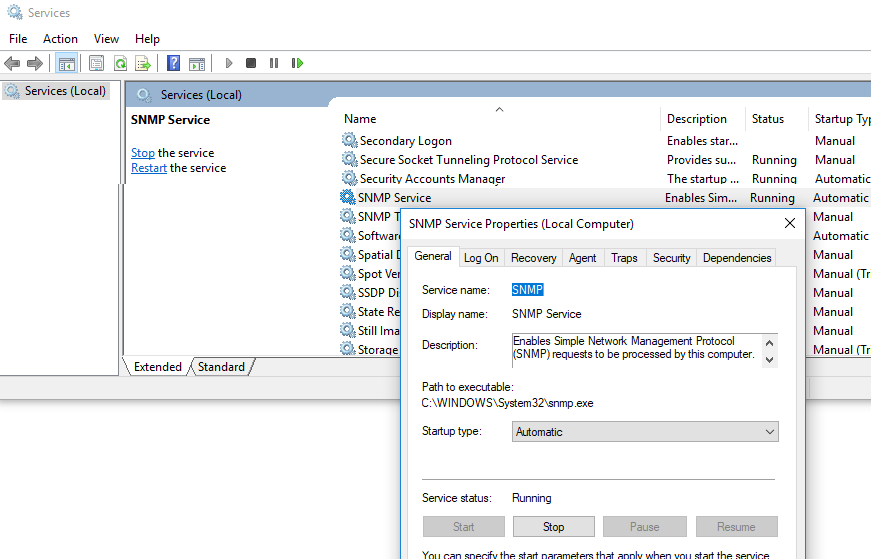
Перейдите на вкладку Agent. Заполните поля contact и location (здесь вы можете указать контактное имя пользователя и местоположение компьютера), и выберите список сервисов, данные которых нужно собирать и отправить устройству мониторинга.
Доступны следующие типы сервисов:
- Physical
- Applications
- Internet
- End-to-end
- Datalink and subnetwork
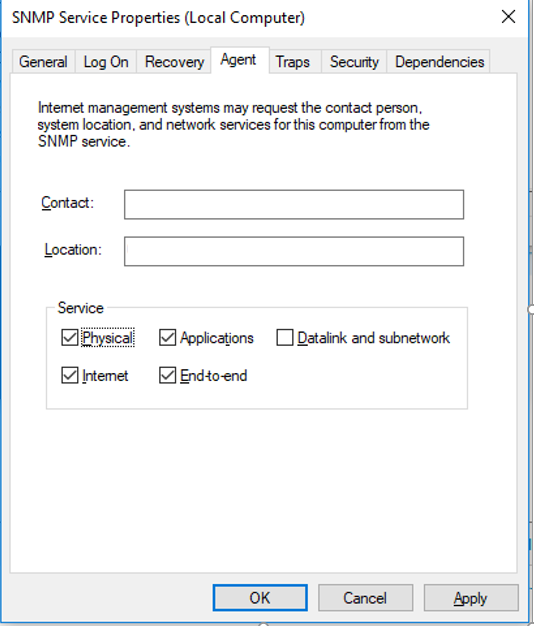
Перейдите на вкладку Security. Здесь вы можете настроить различные параметры безопасности для различных серверов SNMP.
В списке Accepted community names перечислены имена сообществ, чьи SNMP узлы проходят аутентификацию для отправки SNMP-запросов на этот компьютер.
Community — это имя, которое обладает такими же функциями, как логин и пароль.
Нажмите кнопку Добавить и укажите имя Community и один из пяти уровней доступа (None, Notify, READ ONLY, READ WRITE, READ CREATE). READ WRITE – это максимальный уровень доступа, при которых сервер управления SNMP может вносить изменения в систему. В системах мониторинга обычно достаточно выбрать READ ONLY, при этом сервер мониторинга может только опрашивать систему, но не вносить изменения.
В нашем примере мы добавили комьюнити public с разрешениями READ ONLY.
Далее добавьте список серверов системы мониторинга (по DNS имени или по IP адресам), от которых вы хотите разрешить получать SNMP пакеты.
Совет. Вы можете выбрать опцию ‘Принимать пакеты SNMP от любого узла’/Accept SNMP packages from these hosts, но это не безопасно.
Сохраните изменения и перезапустите службу SNMP.
На этом настройка службы SNMP в Windows 10 по сути завершена. Если вам нужно включить SNMP сразу на множестве компьютеров, вы можете удаленно установить и настроить службы с помощью PowerShell или GPO.
Simple Network Management Protocol (SNMP) is an application layer protocol that allows network devices to share information, regardless of the differences in hardware or software. In absence of SNMP, network management tools are unable to identify devices, record network changes, monitor the performance of the network, or ascertain a network device’s status in real-time.
Earlier, you could use the Turn Windows Features on and off section in Control Panel to enable or disable SNMP. Starting Windows 1803 and later, Microsoft has deprecated the feature because of the associated security risks and recommends using the Common Information Model (CIM) instead. Regardless, if you want to install and enable SNMP on your PC, we’ll show you how you can.
How to Enable SNMP From the Settings
SNMP is available as an optional feature on Windows 10. You can enable optional features by navigating to Settings > Apps > Apps & features > Optional features. Click on Add a feature and search for snmp. Select Simple Network Management Protocol (SNMP) and WMI SNMP Provider and click on Install.
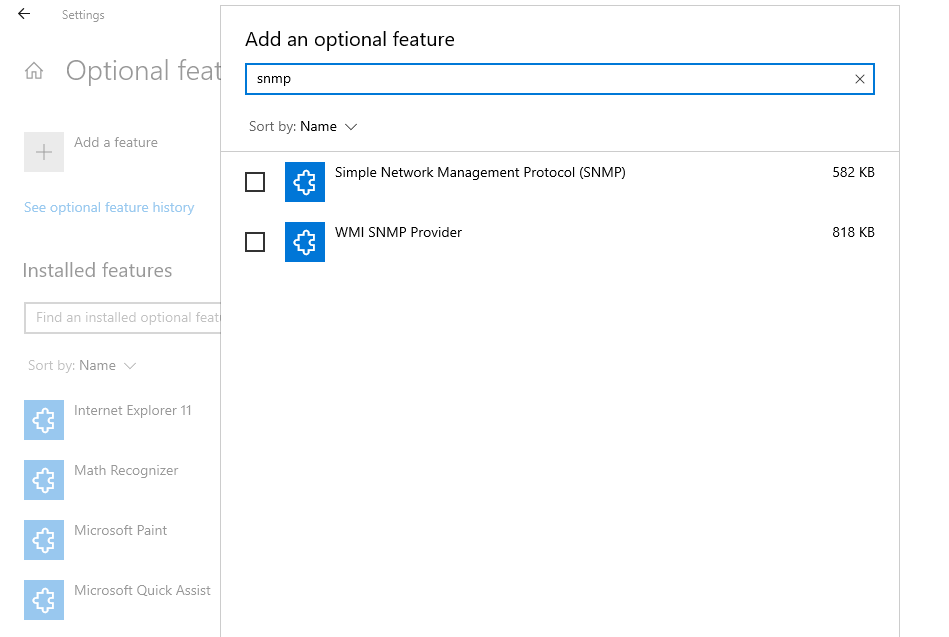
When you’re done, verify if SNMP appears in the Services console.
How to Enable SNMP Using PowerShell
To enable SNMP via PowerShell, first ensure that your computer has internet access. If it does, run an elevated PowerShell by pressing Win + X and selecting Windows PowerShell (Admin). Execute the following command to install the SNMP servers from Microsoft’s servers:
Add-WindowsCapability -Online -Name "SNMP.Client----0.0.1.0"
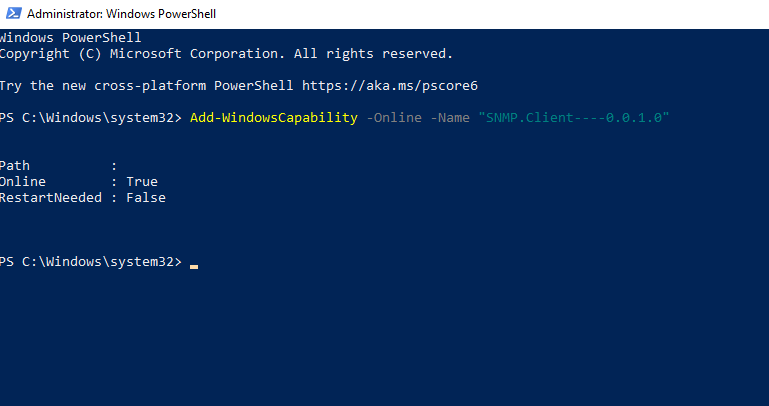
Alternatively, you can also install SNMP using the DISM tool with the following command:
DISM /online /add-capability /capabilityname:SNMP.Client----0.0.1.0
Once you’ve executed either command (Add-WindowsCapability or DISM) successfully, verify that the SNMP service has been install with the following command:
Get-WindowsCapability -Online -Name "SNMP*"
How to Solve Error Code 0x800f0954
If running the command gives you an error message that says «Add-WindowsCapability failed error. Error code = 0x800f0954«, it’s probably because your computer pulls Windows updates from the internal WSUS server instead of the Microsoft Update servers.
You can fix this error by bypassing WSUS and pull installation files for SNMP service from Microsoft Update servers. To do this, follow these steps:
-
Execute the following command to bypass WSUS:
reg add "HKEY_LOCAL_MACHINE\Software\Policies\Microsoft\Windows\WindowsUpdateAU" /v UseWUServer /t REG_DWORD /d 0 /fThis command adds a DWORD value in the «HKEY_LOCAL_MACHINE… \WindowsUpdateAU» registry location and sets its value to 0.
-
Restart the Windows Update service by executing the following 3 commands:
netshh winhttp reset policy
net stop wuauserv
net start wuauserv -
Try installing SNMP again using the Add-WindowsCapability command. If it works, undo the changes you made in the registry in step 1 by executing the following command:
reg add "HKEY_LOCAL_MACHINE\Software\Policies\Microsoft\Windows\WindowsUpdateAU" /v UseWUServer /t REG_DWORD /d 1 /f - Restart the Windows Update service using the commands from step 2.
How to Configure SNMP From Services Panel
Now that you have the SNMP service installed on your PC, let’s configure it.
To start, verify that the SNMP services (SNMP Service and SNMP Trap) are running. Press Win + R, type services.msc, and press Enter to launch the Services panel. Look for both SNMP services and check if they appear in the list.
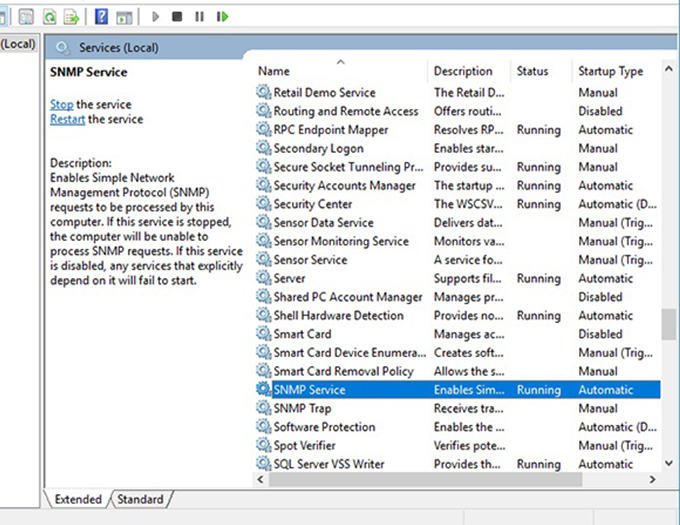
Also, check if the SNMP Service is running. If it’s not, double-click on the service and press Start. Change the Startup type to Automatic to automatically run the service from the next startup.
Next, Switch to the Agent tab and fill in your Contact and Location fields with your name and location. In the Service section, check the boxes for services from which you want to collect data for forwarding it to the monitoring device.
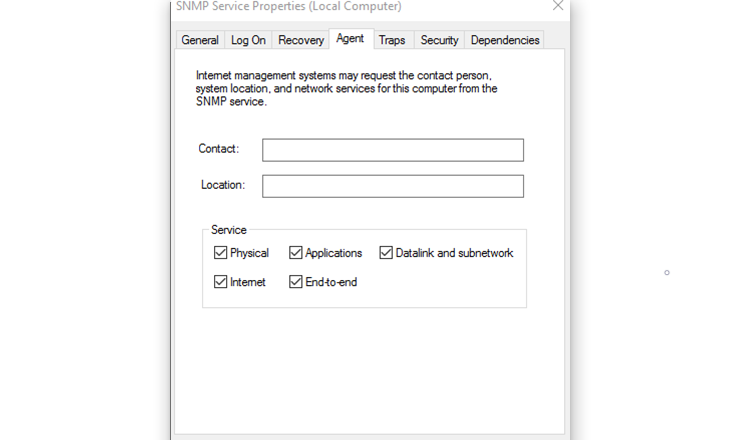
Now, move over to the Security tab.
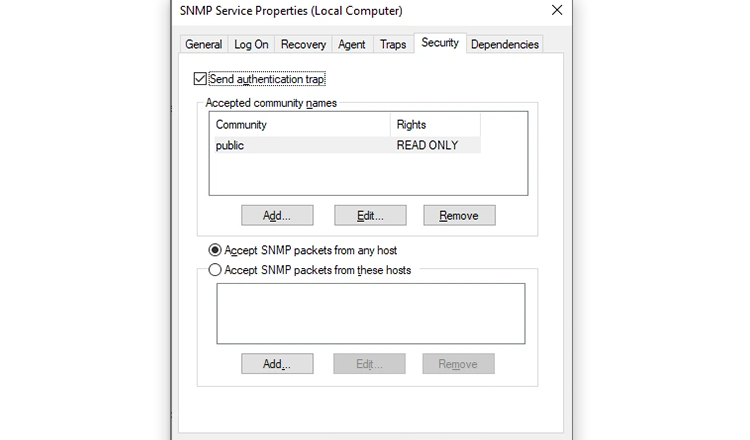
Add the names of the SNMP hosts you want to authenticate in the Accepted community names list. You have the option to provide None, Notify, READ ONLY, READ WRITE, or READ CREATE authentication to the communities.
Next, add the servers from which you want to accept SNMP packets in the next box, and make sure the Accept SNMP packets from these hosts radio button is selected. The Accept SNMP packets from any host option removes all IP restrictions and allows all hosts to send SNMP packets. Watch out, though; this isn’t a safe option to allow, especially on public computers.
When you’re done, press Apply, return to the General tab to restart the service (Click on Stop and then Start), and press OK to exit. Your final step is to open SNMP ports: UDP 161 (SNMP) and UDP 162 (SNMPTRAP). To do this, execute the following commands:
netsh advfirewall firewall add rule name="SNMP UDP Port 161 In" dir=in action=allow protocol=UDP localport=161
netsh advfirewall firewall add rule name="SNMPTRAP UDP Port 162 In" dir=in action=allow protocol=UDP localport=162
netsh advfirewall firewall add rule name="SNMP UDP Port 161 Out" dir=out action=allow protocol=UDP localport=161
netsh advfirewall firewall add rule name=" SNMPTRAP UDP Port 162 Out" dir=out action=allow protocol=UDP localport=162
How to Configure SNMP from Group Policy Editor
You can change Group Policy Object (GPO) parameters to centrally configure SNMP parameters. Launch the Local Group Policy Editor and navigate to Computer Configuration > Administrative Templates > Network > SNMP to configure the parameters.
On the right pane, you’ll see the following:
- Specify communities: permits the addition and authentication of communities that can send SNMP requests.
- Specify permitted managers: permits the addition of hosts that can send SNMP packets to your computer.
- Specify traps for public community: this allows you to configure the name of the hosts the receive trap messages sent by the SNMP service.
Your SNMP Service Is Now Up and Running
Hopefully, things were smooth sailing and you were able to install and configure SNMP on your computer. It’s a little complicated to get running, but hopefully one of the above tricks worked for you.
Network monitoring is important regardless of if you’re at work or resting at home. If you think someone in your family is draining your data caps, or you suspect that malware has made its way onto your computer, you can use tools to track the data moving around your network and catch any greedy culprits.
SNMP is a popular protocol that is used for the exchange of data between devices on a network. SNMP (Simple Network Management Protocol) is most commonly used in modern networks for monitoring, event notification, and device management.
To remotely query a network device via SNMP, it must have an SNMP agent installed.
Let’s see how to install and configure the SNMP service in Windows 10/11 and Windows Server 2022/2019.
Installing SNMP Service on Windows 10 and 11
The SNMP service is available as a separate Feature on Demand (FoD) on Windows 10 and 11, and is not installed by default.
On modern Windows 10 and 11 builds, you can install the SNMP service from the Settings app:
- Click Start > Settings > Apps > Optional Features > Add an optional feature > View features (or run the URI command: Win+R > ms-settings:optionalfeatures);
- Select Simple Network Management Protocol (SNMP) and WMI SNMP Provider (optional) to install;
- Click Next > Install;
- Windows will download the SNMP binaries from the Windows Update servers and install the service.
You can also install the SNMP service on Windows 11 and 10 using PowerShell:
- Open Windows Terminal or PowerShell console as an administrator;
- Check if the SNMP service is not installed (State=NotPresent):
Get-WindowsCapability -Online -Name "*SNMP*"|select name,DisplayName,State
- Install the SNMP service and the WMI SNMP Provider using the commands:
Add-WindowsCapability -Online -Name "SNMP.Client~~~~0.0.1.0" Add-WindowsCapability -Online -Name "WMI-SNMP-Provider.Client~~~~0.0.1.0"
- Wait for the installation to complete;
- Use the Get-Service cmdlet to verify that SNMP service is installed:
Get-Service -Name snmp*
Note. In previous Windows 10 builds (1803-), including Windows 8.1 and 7 you can install the SNMP service using the Turn Windows features on or off applet.
- Run the command: optionalfeatures.exe
- Install the Simple Network Management Protocol (SNMP) and the WMI SNMP Provider

Can’t Install the SNMP Feature on Windows: Error 0x800f0954
SNMP feature is part of the Feature on Demand (FoD) concept, which requires a direct connection to Microsoft’s online update servers for component downloads. You may receive error 0x800f0954 when installing SNMP on a computer that is on an isolated segment or corporate network.
Add-WindowsCapability failed error. Error code = 0x800f0954
This error occurs if your computer is on a corporate network configured to receive Windows updates from an internal WSUS server. The computer is trying to download SNMP binaries from the WSUS server instead of from Microsoft Update servers.
You can allow computers to download optional feature files directly from Windows Update instead of from WSUS:
- Open the Local Group Policy Editor (gpedit.msc);
- Go to Computer Configuration > Administrative Templates > System;
- Enable the GPO option Specify settings for optional component installation and component repair and check the box Download repair content and optional features directly from Windows Updates instead of Windows Server Updates Services (WSUS);
- Update the Group Policy settings on a computer:
gpupdate /force
- Restart the Windows Update service:
Get-Service wuauserv| Restart-Service -Force
Now you can install any Windows optional feature.
In an environment that is not connected to the Internet, you can install SNMP from the offline FoD ISO image:
- Download the FOD media from your Volume License Servicing Center (VLSC)
- Mount the ISO image to a virtual DVD drive (for example, E:)
- Install SNMP using the PowerShell command:
Enable-WindowsOptionalFeature -Online -FeatureName SNMP -Source "E:\Sources\sxs"
Adding SNMP Service on Windows Server 2022/2019
Now let’s see how to the install SNMP service and WMI providers on Windows Server 2022/2019/2016.
SNMP is not installed by default on Windows Server. You can install the SNMP service:
- Via the Server Manager: Add roles and Features > Features > SNMP Service (you can also check SNMP WMI Providers).
- Using PowerShell (this is the only way to install SNMP on Windows Server Core):
Install-WindowsFeature SNMP-Service,SNMP-WMI-Provider –IncludeManagementTools
Note. SNMP is considered as deprecated and may be removed in future Windows builds. Instead of SNMP, it is recommended to use the Common Information Model (CIM).
Enable and Configure SNMP Service on Windows Computer
The SNMP feature adds two new services snap-in:
- SNMP Service — this is the primary SNMP agent service, that tracks activity and sends information;
- SNMP Trap — receives trap messages from local or remote SNMP agents, and forwards messages to the SNMP management app.
Start both SNMP services manually if they are stopped and change the startup type to Automatic.

Open the SNMP Service properties and go to the Agent tab. Fill in the Contact and Location fields (you can specify the user’s contact name and computer location). Then select the list of services from which you want to collect data and send it to the monitoring device. There are five options:
- Physical;
- Applications;
- Internet;
- End-to-end;
- Datalink and subnetwork.
Click the Security tab. Here you can configure various security settings for your SNMP servers.
The list of Accepted community names contains the names of the communities whose SNMP hosts are authenticated to send SNMP requests to this computer. The community’s name has the same functions like login and password.
Click the Add button and specify the Community Name and one of the five access levels:
- None
- Notify
- READ ONLY
- READ WRITE,
- READ CREATE
READ WRITE is the maximum privilege level that allows the SNMP management application to make changes to the computer. For monitoring systems, it is usually enough to select READ ONLY (the monitoring server can only query the device, but cannot make any changes). In this example, we added a community name public with READ ONLY permissions.
Add a list of monitoring servers (IP addresses) to the Accept SNMP packets from these hosts from which you want to accept SNMP packets. This could be your monitoring system, for example, Zabbix, Nagios, Icinga, OpenNMS, PRTG, and Microsoft System Center Operations Manager (SCOM).

Tip. If you select the Accept SNMP packets from any host option, your SNMP agent will accept packets from any host without restrictions. This option is not recommended for use on public computers for security reasons.
Save the changes and restart the SNMP service.
Hint. To enable your Windows host to receive and send SNMP queries and traps, you need to open SNMP ports in Windows Defender Firewall. Two ports are used: UDP 161 (SNMP) and UDP 162 (SNMPTRAP). You can open inbound and outbound SNMP ports in Windows using the following commands:
netsh advfirewall firewall add rule name="SNMP UDP Port 161 In" dir=in action=allow protocol=UDP localport=161 netsh advfirewall firewall add rule name="SNMP UDP Port 161 Out" dir=out action=allow protocol=UDP localport=161 netsh advfirewall firewall add rule name="SNMPTRAP UDP Port 162 In" dir=in action=allow protocol=UDP localport=162 netsh advfirewall firewall add rule name=" SNMPTRAP UDP Port 162 Out" dir=out action=allow protocol=UDP localport=162
Configuring SNMP Settings in Windows via Group Policy
There are several GPO options that allow you to configure SNMP parameters for multiple Windows hosts from a central location. These parameters are located in the GPO editor (gpedit.msc) under Computer Configuration > Policies > Administrative Templates definitions > Network > SNMP.
- Specify communities — specify a list of communities for the SNMP service;
- Specify permitted managers — Specify a list of allowed hosts that can send SNMP queries to the Agen;
- Specify traps for public community — configure Simple Network Management Protocol trap settings.

Another way to configure SNMP parameters is through the registry. These parameters are set in the following Registry Editor key: HKEY_LOCAL_MACHINE\SYSTEM\CurrentControlSet\services\SNMP\Parameters.
You can configure SNMP parameters as needed on a reference computer, export them to a REG file, and deploy the REG file to computers via GPO (Computer Configuration > Preferences > Windows Settings > Registry).
Windows only supports SNMP v1 and SNMP v2c versions. These versions of the protocol are not encrypted. This means that an attacker can intercept all your SNMP data and view it in clear text. Windows doesn’t support SNMP v3, which is an encrypted and more secure protocol.
Cyril Kardashevsky
I enjoy technology and developing websites. Since 2012 I’m running a few of my own websites, and share useful content on gadgets, PC administration and website promotion.
Simple Network Management Protocol (SNMP), is used to monitor, report events, and manage devices on the network. This protocol includes a set of network management standards, including an application layer protocol, and a set of object data. In general, SNMP works by having an agent send and monitor client information to SNMP Manager. By default, port UDP 161 is used to send and receive SNMP messages, and port 162 is used to exchange SNMP traps. Of course, these ports can be changed. In this article, you will learn How To Install And Configure SNMP Service In Windows 10. Do not miss 2021 offers on Eldernode to purchase your own Windows VPS.
Table of Contents
SNMP can receive several different information from different devices such as switches, servers, routers, or computers that have SNMP Agent installed like when the system was on, Performance Counters, and device parameters, and so on. In Windows 10, the SNMP service is available as a separate component that is not installed by default.
By default, the SNMP protocol is disabled on Windows XP, Vista, 7, 8, 10, and on Windows Servers 2003, 2008, 2012, 2016, and you must enable and configure it. Follow us in this tutorial.
How to install SNMP Service in Windows 10
Using the Get-Service PowerShell command, you can check if the SNMP service is enabled on Windows:
Get-Service -Name snmpYou can install the SNMP service from the Control Panel.
Go to Control Panel > Programs and Features > Turn Windows features on or off.
In the Windows feature list, select Simple Network Management Protocol (select SNMP and WMI SNMP Provider ) and then click OK.
Point: This service provides access to SNMP information via Windows Management Instrumentation interfaces.
In addition, you can enable SNMP service using PowerShell:
Enable-WindowsOptionalFeature -online -FeatureName SNMPHow to configure SNMP in Windows 10
After installation, the SNMP service starts automatically. Open the Services management (services.msc) console.
Two new services should be displayed in the list of services:
– SNMP Service: This is the main SNMP agent service that tracks activities and sends information.
– SNMP Trap: Receives trap messages from local or remote SNMP agents and forwards messages to the SNMP management software running on that computer.
Open Properties for SNMP Service. If it is in Stop mode, click the Start button and change its startup type to Automatic.
Click the Agent tab. Fill in the Contact and Location fields (you can specify the username and location of the computer) and select a list of services from which you want to collect data and send it to the monitor. There are five types of services to collect:
1. Physical
2. Applications
3. Internet
4. End-to-end
5. Datalink and subnetwork
Click the Security tab. Here you can configure several different types of settings for SNMP servers.
The Accepted community names list includes the names of the SNMP devices.
The community name has a function similar to the username and password.
Click Add and select Community Name and one of the four access levels (None, Notify, READ ONLY, READ WRITE, and READ CREATE)
Note: READ WRITE is the maximum access level in SNMP.
How to monitor the system using the SNMP service in Windows 10
To monitor the system, you can use READ ONLY, which does not apply any changes to the system.
In this example, we named the community public and access READ ONLY.
Then, in the Accept SNMP packets from these hosts section, enter the list of monitoring servers (name or IP address) from which you want to receive the SNMP package.
You can choose the Accept SNMP packets from any host option, but this is not very secure.
Save the changes and reset the SNMP service. If you want to enable SNMP on multiple hosts or remote servers, you can use PowerShell or Group Policy.
Conclusion
In this article, you learned How To Install And Configure SNMP Service In Windows 10. Installing SNMP Service in Windows 10 was taught firstly using PowerShell commands as well as the control panel. Then, you saw how to configure SNMP in Windows 10. Finally, the way of monitoring the system using the SNMP service in Windows 10 was explained with an example. By installing SNMP monitoring systems can receive the necessary information from the operating system. Complete your knowledge of Windows by spending useful time on Windows tutorials.





